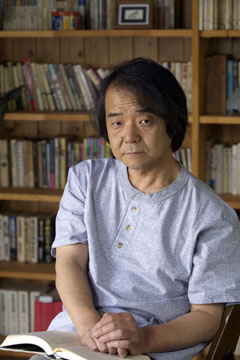Mamoru Oshii: The Venezia Tapes
 | Mamoru Oshii Born in Tokyo on August 8, 1951, Mamoru Oshii is one of the most remarkable personalities in modern Japanese filmmaking. He introduced introspective philosophical speculation into the world of animation, influencing at the same time movie creators all around the globe with his visionary style. Oshii joined the animation industry in 1977. His main works are Urusei Yatsura 2: Beautiful Dreamer (1984) the epoch-making Ghost in the Shell (1995) and Innocence (2004, nominated for the Palme d'Or at the Festival de Cannes). Oshii has also directed a number of live-action features, including Avalon (2001). The Sky Crawlers, was nominated for the Golden Lion at the 65th Venice Film Festival, selected in the 33rd Toronto International Film Festival and was greeted with three awards at Sitges 2008. In 2010 he directed Je t'aime, a short film in collaboration with the Japanese super rock group GLAY, that had its world premiere at Annecy 2010. |
With The Sky Crawlers nominated for the Golden Lion at the 65th Venice Film Festival, Mamoru Oshii spent almost two days of his brief stay in Venice answering to dozens of journalists coming from all over the world. The following is a small selection of Oshii's answers to the most frequently asked questions, collected by the translator who assisted Oshii in those hot days of early September 2008.
Undoubtedly, the kildren are the most intriguing invention in this film, yet not much is said about them. Who are they? Where do they come from?
These children who never become adults are the main reason I picked up Mori's original novel. However, with The Sky Crawlers I never intended to make a science-fiction movie, therefore I intentionally avoided any pseudo-scientific explanation about the real nature of the kildren. They are not mutants or clones or freaks. I did not want to make them into some kind of immortal monsters like vampires or the like. My very personal interpretation, which may not necessarily be Mori's, is that they might just be convinced they're immortal. And as long as many people around them think the same, their immortality becomes a matter of fact. What is "reality" after all if not something believed by a greater number of people?
The kildren are a Peter Pan generation. I have always wondered what would happen if Peter Pan had fallen in love. The answer is that he'd probably stop flying.
In one of the most intense sequences of the film, Suito declares that peace cannot exist without war. Isn't it an extreme statement?
I'm certainly not the first one who expresses this concept. We can declare that we all want peace, but if we look back we must admit that our path throughout history is a sequence of wars. We can see history in two ways: peace interrupted by wars, or a warring situation interrupted by oases of peace. Shouldn't we be more objective in observing our terrible inner nature? Why are we always looking for competition? Why do we rejoice, sometimes very violently, when our team wins a soccer world cup match against another country?
The aircrafts design is quite unique. Do you think they could actually fly?
In this movie, war is staged as a show, so it is meant to be clearly seen by everyone. It's a world where computers exist, as we can see one in Suito's office, so we may assume that these people have enough technology to develop a jet engine. But jet engine aircrafts would fly too fast to be seen on TV, so they use slower propeller planes. High speed, otherwise a first priority in air warfare, is not required here. I also wanted the fighters piloted by the kildren to look like toys that even children could handle. Finally, I wanted some kind of original design that could be unique to this film. We actually took elements from real WWII planes and recombined them to create machines that nobody had ever seen before, and yet that could be convincing and realistic. Reciprocating engine airplanes with pushing propellers were actually developed at prototype stage, but were never mass-produced due to the advent of jet engines.
Many viewers are puzzled with the old man sitting on the steps at the drive in. Who is he?
The Sky Crawlers is a story about children. And to represent children, I needed fathers and mothers, too. The movie is built around an almost mythological framework. It is about parricide, with an invincible and threatening, yet faraway if not even absent father dominating the heavens. The Teacher's fighter, the J-2, has an intentionally phallus-like long spinner. Then we have a pampering great mother on the ground who welcomes the kildren back after each mission, and repairs their planes. But I also wanted to depict the three ages of man. Yuichi is the child, the Teacher is the adult man, and then we have the old man sitting on the steps outside the diner. He's Yuichi's possible future, but Yuichi is apparently unable to figure it out, so he stares at him as you'd look at some kind of ornament on a cupboard, unable to communicate with him.
Another puzzling element in the movie is the quotation from Camus' The Stranger.
I'm very sorry to disappoint you, but the quotation from Camus in the first lines of conversation between Yuichi and Suito has not a very deep meaning. I used it because I wanted to stage an encounter where two people, two perfect strangers are exploring each other trying to understand whether they can get along or not. Yuichi suddenly speaks this famous passage from Camus' The Stranger, "the glare of the sun was unbearable" and Suito immediately understands where those words are coming from. The two have discovered that they have something in common, they have established a contact. This is all, really.

![WORK LIST[DETAILS]](/contents/works/design/images/left_title.gif)



 terms of use
terms of use